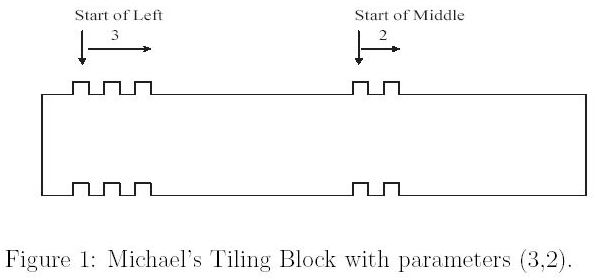poj1609 Tiling Up Blocks
来源:互联网 发布:淘宝热卖排行榜前十 编辑:程序博客网 时间:2024/05/20 18:44
Tiling Up Blocks
Time Limit: 1000MS Memory Limit: 10000KTotal Submissions: 4964 Accepted: 1946
Description
Michael The Kid receives an interesting game set from his grandparent as his birthday gift. Inside the game set box, there are n tiling blocks and each block has a form as follows:

Each tiling block is associated with two parameters (l,m), meaning that the upper face of the block is packed with l protruding knobs on the left and m protruding knobs on the middle. Correspondingly, the bottom face of an (l,m)-block is carved with l caving dens on the left and m dens on the middle.
It is easily seen that an (l,m)-block can be tiled upon another (l,m)-block. However,this is not the only way for us to tile up the blocks. Actually, an (l,m)-block can be tiled upon another (l',m')-block if and only if l >= l' and m >= m'.
Now the puzzle that Michael wants to solve is to decide what is the tallest tiling blocks he can make out of the given n blocks within his game box. In other words, you are given a collection of n blocks B = {b1, b2, . . . , bn} and each block bi is associated with two parameters (li,mi). The objective of the problem is to decide the number of tallest tiling blocks made from B.

Each tiling block is associated with two parameters (l,m), meaning that the upper face of the block is packed with l protruding knobs on the left and m protruding knobs on the middle. Correspondingly, the bottom face of an (l,m)-block is carved with l caving dens on the left and m dens on the middle.
It is easily seen that an (l,m)-block can be tiled upon another (l,m)-block. However,this is not the only way for us to tile up the blocks. Actually, an (l,m)-block can be tiled upon another (l',m')-block if and only if l >= l' and m >= m'.
Now the puzzle that Michael wants to solve is to decide what is the tallest tiling blocks he can make out of the given n blocks within his game box. In other words, you are given a collection of n blocks B = {b1, b2, . . . , bn} and each block bi is associated with two parameters (li,mi). The objective of the problem is to decide the number of tallest tiling blocks made from B.
Input
Several sets of tiling blocks. The inputs are just a list of integers.For each set of tiling blocks, the first integer n represents the number of blocks within the game box. Following n, there will be n lines specifying parameters of blocks in B; each line contains exactly two integers, representing left and middle parameters of the i-th block, namely, li and mi. In other words, a game box is just a collection of n blocks B = {b1, b2, . . . , bn} and each block bi is associated with two parameters (li,mi).
Note that n can be as large as 10000 and li and mi are in the range from 1 to 100.
An integer n = 0 (zero) signifies the end of input.
Note that n can be as large as 10000 and li and mi are in the range from 1 to 100.
An integer n = 0 (zero) signifies the end of input.
Output
For each set of tiling blocks B, output the number of the tallest tiling blocks can be made out of B. Output a single star '*' to signify the end of
outputs.
outputs.
Sample Input
33 21 12 354 22 43 31 15 50
Sample Output
23*
这道题按照第一维降序排序后,就是LIS了,不过数据量大,需要O(nlogn)的算法。
代码:
#include<cstdio>#include<algorithm>#include<iostream>using namespace std;struct block{ int l,m; bool operator<(const block &a)const{ if(l==a.l) return m>a.m; return l>a.l; }}p[10010];struct cmp{ bool operator()(const int &a,const int &b)const{ return a>b; }};int dp[10010];int main(){ int n,a,b; while(scanf("%d",&n),n){ for(int i=0;i<n;i++){ scanf("%d%d",&p[i].l,&p[i].m); } sort(p,p+n); dp[0]=p[0].m; int tot=1; for(int i=1;i<n;i++){ int id=upper_bound(dp,dp+tot,p[i].m,cmp())-dp; dp[id]=p[i].m; if(id==tot) ++tot; } printf("%d\n",tot); } puts("*");return 0;}但是此题有更好的解法,dp[i][j]表示第一维小于等于i并且第二维小于等于j的最优解,那么dp[i][j]=max(dp[i][j-1],dp[i-1][j]}+w[i][j];
0 0
- poj1609 Tiling Up Blocks
- POJ1609 Tiling Up Blocks
- poj1609 Tiling Up Blocks
- POJ1609:Tiling Up Blocks(DP)
- poj1609 - Tiling Up Blocks(动归)
- poj1609——Tiling Up Blocks
- poj1609 Tiling Up Blocks(LIS)
- POJ1609 UVALive2815 UVA1196 ZOJ1787 Tiling Up Blocks【二维最长上升子序列+DP】
- pku1609 Tiling Up Blocks
- Tiling Up Blocks (LIS)
- poj 1609 Tiling Up Blocks
- POJ 1609 Tiling Up Blocks.
- poj 1609 Tiling Up Blocks
- 1609 Tiling Up Blocks 解题报告
- pku1609 Tiling Up Blocks (DP题)
- poj 1609 Tiling Up Blocks 动态规划
- Tiling Up Blocks - POJ 1609 dp
- poj 1609 Tiling Up Blocks(DP)
- el表达式判断是否为空
- sscanf函数用法
- hdu 4586——Play the Dice
- FPC的编译宏
- 【Django】创建模板
- poj1609 Tiling Up Blocks
- android界面跳转
- LeetCode:Insertion Sort List (Java)
- 雅思阅读医学类基本常用词汇
- hdu2546 饭卡
- JavaSe基础XX06——面向对象
- 在Linux上安装Hadoop
- 黑马程序员—java高新技术(1)
- 润乾报表使用心得


